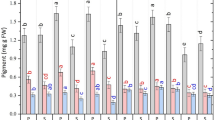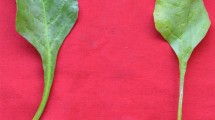Abstract
The present study was aimed to investigate the health of vegetative and reproductive parts of sesame plants during Bacillus methylotrophicus KE2 interaction by their pigments, sugars, organic acid, amino acids, hormones and antioxidant production analysis. In a green-house study, B. methylotrophicus KE2 was sprayed to sesame plants at late flowering stage. The bacterial treatment enhanced photosynthetic pigments of plants including pods than their controls. The shoots of plants had higher amount of sucrose, glucose, galactose, xylitol and malic acid, and while the pods of plants showed the more accumulation of sucrose, glucose, inulin and xylitol in bacterium treated plants. However, alanine, cysteine, valine, isoleucine, leucine, tyrosine, phenylalanine, arginine and proline content in shoots and cysteine in pods were increased by the effect of KE2 inoculation. Salicylic acid production was declined in shoots and increased in pods during bacterial exposure. In addition, abscisic acid concentration was lower in pods due to the effect of B. methylotrophicus KE2 in pods over controls. The total polyphenol synthesis was increased in shoots and pods of sesame plants by bacterial interaction. The results of this study revealed that foliar spray of B. methylotrophicus KE2 on sesame plants triggered the plant growth promoting and defense metabolites in vegetative and reproductive organs to improve the health status of sesame.


Similar content being viewed by others
References
Hua JL, Liu GR, Huang JS (2012) Effect of continuous cropping of sesame on rhizospheric microbial communities. Acta Ecol Sin 32:2936–2942
Radhakrishnan R, Shim KB, Lee BW, Hwang CD, Pae SB, Park CH, Kim SU, Lee CK, Baek IY (2013) IAA producing Penicillium sp. NICS01 triggers plant growth and suppresses Fusarium sp.-induced oxidative stress in sesame (Sesamum indicum L.). J Microbiol Biotechnol 23:856–863. doi:10.4014/jmb.1209.09045
Radhakrishnan R, Khag SM, Baek IY, Lee IJ (2014) Characterization of plant growth-promoting traits of Penicillium species against the effects of high soil salinity and root disease. J Plant Interact 9:754–762. doi:10.1080/17429145.2014.930524
Kang SM, Radhakrishnan R, You YH, Joo GJ, Lee IJ (2014) Phosphate solubilizing Bacillus megaterium mj1212 regulates endogenous plant carbohydrates and amino acids contents to promote mustard plant growth. Ind J Microbiol 54:427–433. doi:10.1007/s12088-014-0476-6
Kang SM, Radhakrishnan R, Youb YH, Khan AL, Park JM, Lee SM, Lee IJ (2015) Cucumber performance is improved by inoculation with plant growth-promoting microorganisms. Acta Agric Scand Sec B Soil Plant Sci 65:36–44. doi:10.1080/09064710.2014.960889
Ahemad M, Kibret M (2014) Mechanisms and applications of plant growth promoting rhizobacteria: current perspective. J King Saud Univ Sci 26:1–20. doi:10.1016/j.jksus.2013.05.001
Kang SM, Radhakrishnan R, Khan AL, Kim MJ, Park JM, Kim BR, Shin DH, Lee IJ (2014) Gibberellin secreting rhizobacterium, Pseudomonas putida H-2-3 modulates the hormonal and stress physiology of soybean to improve the plant growth under saline and drought conditions. Plant Physiol Biochem 84:115–124. doi:10.1016/j.plaphy.2014.09.001
Haas D, Defago G (2005) Biological control of soil-borne pathogens by fluorescent Pseudomonas. Nat Rev Microbiol 3:307–319. doi:10.1038/nrmicro1129
Kilian M, Steiner U, Krebs B, Junge H, Schmiedeknecht G, Hain R (2000) FZB24® Bacillus subtilis-mode of action of a microbial agent enhancing plant vitality. Pflanzenschutz Nachr Bayer 1:72–93
Sharma RR, Singh D, Singh R (2009) Biological control of postharvest diseases of fruits and vegetables by microbial antagonists: a review. Biol Control 50:205–221. doi:10.1016/j.biocontrol.2009.05.001
Devi VS, Rao PA, Sharma SP, Sharma HC (2014) Interaction of acid exudates in chickpea with biological activity of Bacillus thuringiensis towards Helicoverpa armigera. J Appl Entomol 138:289–296. doi:10.1111/jen.12056
Radhakrishnan R, Lee IJ (2016) Gibberellins producing Bacillus methylotrophicus KE2 supports plant growth and enhances nutritional metabolites and food values of lettuce. Plant Physiol Biochem 109:181–189. doi:10.1016/j.plaphy.2016.09.018
Arnon DI (1949) Copper enzyme in isolated chloroplasts and polyphenoloxidase in Beta vulgaris. Plant Physiol 24:1–15
Lichtenthaler HK (1987) Chlorophylls and carotenoids: pigment of photosynthetic biomembranes. Med Enzymol 148:350–382
Hinesley LE, Pharr DM, Snelling LK, Funderburk SR (1992) Foliar raffinose and sucrose in four conifer species relationship to seasonal temperature. J Am Soc Hortic Sci 117:852–855
Kumazawa S, Hamasaka T, Nakayama T (2004) Antioxidant activity of propolis of various geographic origins. Food Chem 84:329–339. doi:10.1016/S0308-8146(03)00216-4
Steyn WJ, Wand SJE, Holcroft DM, Jacobs G (2002) Anthocyanins in vegetative tissues: a proposed unified function in photoprotection. New Phytol 155:349–361. doi:10.1046/j.1469-8137.2002.00482.x
Eichert T, Goldbach HE (2008) Equivalent pore radii of hydrophilic foliar uptake routes in stomatous and astomatous leaf surfaces - further evidence for astomatal pathway. Physiol Plant 132:491–502. doi:10.1111/j.1399-3054.2007.01023.x
Rolland F, Baena-Gonzalez E, Sheen J (2006) Sugar sensing and signaling in plants: conserved and novel mechanisms. Annu Rev Plant Biol 57:675–709. doi:10.1146/annurev.arplant.57.032905.105441
Wang X, Chang L, Wang B, Wang D, Li P, Wang L, Yi X, Huang Q, Peng M, Guo A (2013) Comparative proteomics of Thellungiella halophila leaves under different salinity revealed chloroplast starch and soluble sugar accumulation played important roles in halophyte salt tolerance. Mol Cell Proteomics 12:2174–2195. doi:10.1074/mcp.M112.022475
Thibaud MC, Gineste S, Nussaume L, Robaglia C (2004) Sucrose increases pathogenesis-related PR-2 gene expression in Arabidopsis thaliana through an SA-dependent but NPR1-independent signaling pathway. Plant Physiol Biochem 42:81–88. doi:10.1016/j.plaphy.2003.10.012
Stolle-Smits T, Beekhuizen JG, Kok MTC, Pijnenburg M, Recourt K, Derksen J, Voragen AGJ (1999) Changes in cell wall polysaccharides of green bean pods during development. Plant Physiol 121:363–372. doi:10.1104/pp.121.2.363
Louvet R, Rayon C, Domon JM, Rusterucci C, Fournet F, Leaustic A, Crepeau MJ, Ralet MC, Rihouey C, Bardor M, Lerouge P, Gillet F, Pelloux J (2011) Major changes in the cell wall during silique development in Arabidopsis thaliana. Phytochem 72:59–67. doi:10.1016/j.phytochem.2010.10.008
Gonzalez-Rodriguez RM, Serrato R, Molina J, Aragon CE, Olalde V, Pulido LE, Dibut B, Lorenzo JC (2013) Biochemical and physiological changes produced by Azotobacter chroococcum (INIFAT5 strain) on pineapple in vitro-plantlets during acclimatization. Acta Physiol Plant 35:3483–3487. doi:10.1007/s11738-013-1373-z
Radhakrishnan R, Lee IJ (2014) Effect of low dose of spermidine on physiological changes in salt stressed cucumber plants. Russian J Plant Physiol 61:90–96. doi:10.1134/S1021443714010129
Fabian F, Blum H (1943) Relative taste potency of some basic food constituents and their competitive and compensatory action. Food Sci 8:179–193. doi:10.1111/j.1365-2621.1943.tb16560.x
Werbach MR (2000) Nutritional strategies for treating chronic fatigue syndrome. Altern Med Rev 5:93–108
Jones DL, Healey JR, Willett VB, Farrar JF, Hodge A (2005) Dissolved organic nitrogen uptake by plants an important N uptake pathway? Soil Biol Biochem 37:413–423. doi:10.1016/j.soilbio.2004.08.008
Kang S, Radhakrishnan R, Lee SM, Park YG, Kim AY, Seo CW, Lee IJ (2015) Enterobacter sp. SE992-induced regulation of amino acids, sugars, and hormones in cucumber plants improves salt tolerance. Acta Physiol Plant 37:149. doi:10.1007/s11738-015-1895-7
Radhakrishnan R, Lee IJ (2013) Ameliorative effects of spermine against osmotic stress through antioxidants and abscisic acid changes in soybean pods and seeds. Acta Physiol Plant 35:263–269. doi:10.1007/s11738-012-1072-1
Zhu SQ, Chen MW, Ji BH, Jiao DM, Liang JS (2011) Roles of xanthophylls and exogenous ABA in protection against NaCl induced photo-damage in rice (Oryza sativa L) and cabbage (Brassica campestris). J Exp Bot 62:4617–4625. doi:10.1093/jxb/err170
Sreenivasulu N, Grimm B, Wobus U, Weschke W (2000) Differential response of antioxidant compounds to salinity stress in salt tolerant and salt sensitive seedlings of foxtail millet (Setaria italica). Physiol Plant 109:435–442. doi:10.1034/j.1399-3054.2000.100410.x
Acknowledgement
Authors thank Rural Development Administration, Republic of Korea for providing financial support through Agenda Program (Project No. PJ01228603).
Author information
Authors and Affiliations
Corresponding author
Electronic supplementary material
Below is the link to the electronic supplementary material.
12088_2017_666_MOESM1_ESM.doc
Supplementary Fig. 1. Effect of B. methylotrophicus KE2 on seed germination of sesame. Means (n = 30) followed by the same letter were not significantly different (p ≤ 0.05) according to Duncan’s multiple range test. (DOC 48 kb)
Rights and permissions
About this article
Cite this article
Radhakrishnan, R., Lee, IJ. Foliar Treatment of Bacillus Methylotrophicus KE2 Reprograms Endogenous Functional Chemicals in Sesame to Improve Plant Health. Indian J Microbiol 57, 409–415 (2017). https://doi.org/10.1007/s12088-017-0666-0
Received:
Accepted:
Published:
Issue Date:
DOI: https://doi.org/10.1007/s12088-017-0666-0




